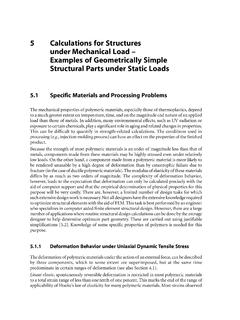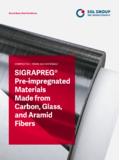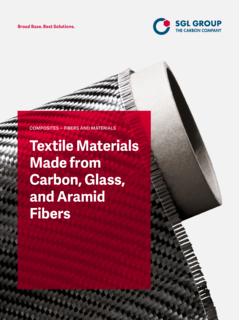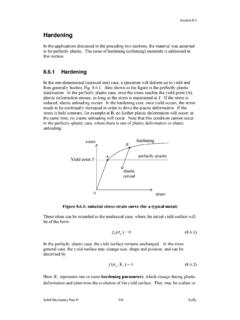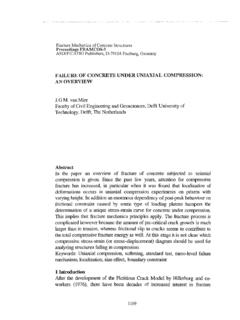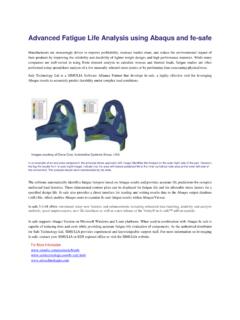Transcription of MANUFACTURING PROPERTIES of ENGINEERING …
1 ITU Department of Mechanical ENGINEERING MANUFACTURING PROPERTIES of ENGINEERING MATERIALS Lecture Notes Aran 2007 AHMET ARAN - MFG PROP V1 1 CONTENTS 1. ENGINEERING Materials and Their PROPERTIES Classification of ENGINEERING Materials PROPERTIES of ENGINEERING Materials Mechanical PROPERTIES Thermal PROPERTIES Environmental PROPERTIES Electrical PROPERTIES 2. MANUFACTURING Processes and Manufacturability Casting and Castability Casting Process: Castability: Material PROPERTIES Which Affect Castability Bulk Forming PROPERTIES Which Effect Formability Sheet Metal Forming Machining Joining Other Processes AHMET ARAN - MFG PROP V1 2 1. ENGINEERING Materials and Their PROPERTIES In this Chapter materials are classified and the most important PROPERTIES of the ENGINEERING materials are listed with short explanations.
2 The PROPERTIES covered here are especially those PROPERTIES , which are important in MANUFACTURING processes. Classification of ENGINEERING Materials A. Metals and Alloys: Inorganic materials composed of one or more metallic elements. They usually have a crystalline structure and are good thermal and electrical conductors. Many metals have high strength and high elastic module. They maintain their good strength at high and low temperatures. They also have sufficient ductility, which is important for many ENGINEERING applications. They can be strengthened by alloying and heat treatment. They are least resistant to corrosion. B. Ceramics and Glasses: Inorganic materials consisting of both metallic and non-metallic elements bonded together chemically. They can be crystalline (ceramics), non-crystalline (glasses) or mixture of both (glass-ceramics).
3 Generally they have high melting points and high chemical stabilities. They have high hardness, high moduli and high temperature strength. But since they are very brittle they cannot be used as good as metals. Ceramics are usually poor electrical conductors. Ceramics have a high strength on compression C. Polymers: Organic materials which consist of long molecular chains or networks containing carbon. Most polymers are non-crystalline, but some consist of mixtures of both crystalline and non-crystalline regions. They generally have low densities and low rigidity. Their mechanical PROPERTIES may vary considerably. Most polymers are poor electrical conductors due to the nature of the atomic bonding. Most of them are corrosion resistant, but cannot be used at high temperatures.
4 They generally have a good strength to weight ratio. D. Composites: Materials where two or more of the above materials are brought together on macroscopic level. Usually they consist of a matrix and a reinforcement. They are designed to combine the best PROPERTIES of each of its components. AHMET ARAN - MFG PROP V1 3 PROPERTIES of ENGINEERING Materials Each material has a property profile. The PROPERTIES of ENGINEERING materials can be classified into the following main groups: physical and chemical. The physical PROPERTIES can also be further grouped into categories: mechanical, thermal, electrical, magnetic, optical etc. The chemical PROPERTIES include: environmental and chemical stability. There are also some general PROPERTIES which cannot be classified within these groups: Density, (Units: Mg/m3, g/cm3) The density of a material is defined as its mass (m) per unit volume (V).
5 It is represented in the following equation; = m / V Cost (YTL/kg) Anisotropy Definition: The characteristic of exhibiting different values of a property in different directions. Ex: Rubber reinforced with horizontally placed fibers has a high ultimate tensile strength if pulled parallel to the fibers horizontally, but a relatively low one if pulled vertically. AHMET ARAN - MFG PROP V1 4 Mechanical PROPERTIES TENSILE TEST AHMET ARAN - MFG PROP V1 5 Elastic modulus (Young Modulus), E (Unit: GPa) Young's modulus, E, is the slope of the initial, linear-elastic part of the stress-strain curve in tension or compression. But accurate moduli are measured dynamically. It is a measure of the rigidity of the material. Young s Modulus (or Elastic Modulus) is the proportionality constant of solids between elastic stress and elastic strain and describes the inherent (natural) stiffness of a material.
6 It can be expressed in the following equation where, E is Young s Modulus; E = Elastic Stress / Elastic Strain Tangent modulus: (slope of the stress-strain curve at a certain point) Secant modulus: (slope of a line from the origin to a specified point) For isotropic materials it is related to the bulk modulus K and to the shear modulus G by where is Poisson's ratio. Commonly v = 1/3, and hence E = K, and E = (8/3)G. AHMET ARAN - MFG PROP V1 6 Shear Modulus, G (Unit: GPa) The shear modulus is the initial, linear elastic slope of the stress-strain curve in shear. Shear modulus is the ratio of shear stress divided by the shear strain in the elastic region. It can also be referred to as modulus of rigidity or torsion modulus. G = Elastic Shear Stress / Elastic Shear Strain For isotropic materials it is related to Young's modulus E and to the bulk modulus K and Poisson's ratio by When v = 1/3, G = (3/8)E, and G = (3/8)K.
7 AHMET ARAN - MFG PROP V1 7 Bulk Modulus K, (Unit: GPa) The bulk modulus, K, measures the elastic response to hydrostatic pressure. Ratio of mean normal stress to the change in volume Units: SI: GPa; cgs: dyne/cm2; English: psi where V is the volume. For isotropic solids it is related to Young's modulus E and to the shear modulus G by where v is Poisson's ratio. When v = 1/3, E = K, and K = (8/3)G. Poissons Ratio, v, (Dimensionless) Poisson s Ratio is the negative ratio of the thickness decrease divided by the length increase as a result of a tensile stress applied to a material. Its value for many solids is close to 1/3. For elastomers it is just under AHMET ARAN - MFG PROP V1 8 Elastic limit, el (Unit: MPa) The elastic limit (proportionality limit) is the stress beyond which there is permanent deformation.
8 Below the elastic limit all the deformation is recovered when the load is removed. The 'elastic limit' of a solid requires careful definition. For metals, the elastic limit is defined as the offset yield strength. This represents the stress at which the stress-strain curve for uniaxial (=in one direction) tensile loading deviates by a strain of from the linear-elastic line. It is the stress at which dislocations move large distances through the crystals of the metal. It is the same in tension and compression as the dislocations movement is caused by the shear stress, which has its highest value at 45 to the axis of loading. For polymers, the elastic limit is the stress at which the uniaxial stress-strain curve becomes markedly non-linear: typically, a strain of 1%. This may be caused by 'shear yielding' (irreversible slipping of molecular chains) or by 'crazing' (formation of low density, crack-like volumes which scatter light, making the polymer look white).
9 For fine ceramics and glasses, the database entry for the elastic limit is an estimate, based on the tensile strength (which is low due to brittle fracture). When based on direct measurements at high pressures, or on hardness measurements, of the stress required to cause plastic flow, it is very high: higher than the compressive strength, which is lowered by crushing. For composites, the elastic limit is best defined by a set deviation from linear-elastic uniaxial behaviour: is taken in the database. AHMET ARAN - MFG PROP V1 9 Elastic limit depends on the mode of loading. For modes of loading other than uniaxial tension, such as shear and multiaxial loading, the strength is related to that in simple tension by a yield function. For metals, the Von Mises yield function works well.
10 It specifies the relationship between the principal stresses 1, 2, 3 and the yield strength sy (elastic limit): The Tresca function is sometimes more convenient, because it is less complicated: For ceramics, a Coulomb flow law is used: Resilience The maximum amount of energy per unit volume which can be stored elastically. This energy is released upon unloading. This value can be calculated as the area under the elastic part of the stres-strain curve. AHMET ARAN - MFG PROP V1 10 Yield Strength (Unit: MPa) The stress at which a material exhibits a specified deviation from proportionality of stress and strain (Flow stres). An offset of is used for many metals. Only certain metals have a yield point (metals with BCC-Body Centered Cubic crystal structure such as iron).
